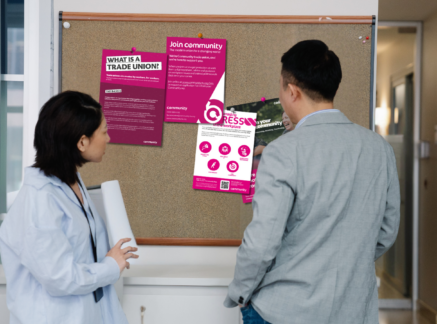As trade unionists, we are always looking for ways to strengthen our collective power, grow our membership and better represent our members.
No matter what sector or industry you work in, mapping is important, there is no denying that. It helps us to understand our workplaces, identify key stakeholders and the issues affecting our members. However, when mapping, it is important to champion the most human, fundamental and often most effective tool as your disposal – the one-to-one conversation.
While your map can take many forms, from a simple hand drawn diagram to a detailed spreadsheet, the richest, most nuanced information about your workplace cannot be found in any database; it is held in the experienced, concerns and hopes of your colleagues. The only way to unlock this information is through genuine, face-to-face (or screen-to-screen if you can’t meet them in person) dialogue.
In this blog, we’ll explore how you can use one-to-one conversations as an effective part of your workplace mapping efforts.

Active listening
Active listening is not just about waiting for your turn to speak; it is about truly hearing what people are saying, both explicitly and implicitly. This includes:
- Giving your full attention: Make sure to put away any devices that could distract you, make eye contact and show you’re engaged.
- Listening to understand: When someone is speaking, try not to formulate your answer while they’re still talking as it will distract you from what they are trying to convey. Listen to what they have to say, their tone and monitor their body language.
- Reflecting and summarising: If they have discussed a specific issue with you, ensure you summarise what they have said to ensure you have heard them correctly, and give them the opportunity to correct or elaborate e.g. if a colleague has highlighted concerns over accessibility, you could respond with “So, if I’m understanding correctly, you’re wanting to bring attention to management the fact that the building has no disability access. Is that correct?”
- Empathising: If a colleague is upset or frustrated, ensure you acknowledge their feelings with responses such as “That sounds incredibly frustrating” or “I can see why that would worry you.” This helps build trust.
Active listening is not just about collecting data; it is about building trust and rapport with your branch. By truly listening to your colleagues’ issues, you are respecting their issues and feelings, and in doing so, people will feel more likely to open up and approach you.

Asking open-ended questions
Closed questions (those that elicit a one-word response, such as “yes” or “no”) have their place, however they won’t help you map complexities of your workplace. For that, you need open-ended questions that encourage both members and non-members to respond with detail.
For example, instead of asking “Do you feel safe at work?” which would elicit a “yes” or “no response,” you could try:
- “Could you let me know about any health or safety concerns you have at work right now?”
- “If you could change one thing about our workplace to make it safer, what would it be and why?”
- “How safe do you feel at work with the recent changes to the floor?”
- “What would you say are the biggest issues around health and safety here?”
By asking open-ended questions, such as the above, you are encouraging your colleagues to elaborate on their experiences, highlight priorities and reveal underlying issues that you may not have even considered. This is especially useful when talking with colleagues who work on a different shift pattern or floor.
Each response will provide you with in-depth information for your mapping efforts, allowing you to identify common issues, uncover key stakeholders and pinpoint areas of potential collective action.
Have conversations with members and non-members
The power of one-to-one conversations should not just be limited to just Community members; you should also speak with non-members to get an insight into their thoughts and issues to help address common issues (and hopefully recruit them into becoming members of our union).
With members:
- Deepening engagement: You should understand their specific grievances, aspirations and motivations to be a part of Community. This will help you to tailor your campaigns and communications.
- Identifying key leaders: One-to-one conversations will help you to identify which of your members are engaged with the union and therefore would make great Community Reps or activists.
- Gathering testimonials: Individual experiences and stories are powerful. You should encourage members to share their issues, and how the union has helped them at work to use in both local and national union campaigns.
- Understanding branch strengths and weaknesses: You should speak to members about what they value about the union, what they think could be done better and what they would like to see. Member feedback is crucial in improving your branch map.
With non-members:
- Identifying barriers to membership: Find out why non-members haven’t joined. Is it due to misinformation, apathy, fear or not seeing the value in being a Community member? Understanding and addressing these barriers is crucial for effective recruitment.
- Highlighting concerns: What issues are affecting non-members, and how can the union support them? Non-members, especially on shift patterns or floors were there is limited or no representation at all can provide brilliant insights into the issues affecting them, and how you can use your map to recruit and organise.
- Assessing perceptions: What do non-members think a union like Community does? Do they have any misconceptions that you need to address?
- Building relationships: Not everyone will join Community as soon as you ask them to, however, even if they don’t, a positive, respectful conversation can help plant a seed. Building relationships with non-members shows them you’re approachable and genuinely interested in their well-being. It’s about showing solidarity, not just selling membership.
- Identifying undiscovered leaders: Like with members, you may find non-members who would make brilliant Community Reps or activists, so make sure to add them to your map!

Transforming conversation into action
Every conversation you have with members, non-members and stakeholders, when approached with active listening and open-ended questions becomes information for your workplace map.
The best part? Even after having just several one-to-one conversations, you will begin to see patterns, including common issues, key stakeholders and activists, and organising opportunities. This will be the bedrock to any organising activity you undertake to transform your workplace and branch for the better.
Make sure to record everything you have learned during one-to-one conversations and share with other Community Reps for future organising efforts and opportunities.
Workplaces are dynamic, and your map should be too; it should grow and develop over time as your conversations do, so ensure thar you are regularly engaging in one-to-one conversations to keep your map updated. For example, five of your colleagues on a night shift have raised concerns over unsuitable PPE and equipment, as well as a lack of training. Further to this, one of the colleagues is especially vocal about these issues and would like to be kept up to date with any developments. From this scenario, you have not only identified a priority issue to organise around, but also identified a potential activist who may make a good Health and Safety Rep. By adding this information to your workplace map, you will have mapped an issue, a group of workers to organise around and even identified a potential leader – all from having a conversation.
So, the next time you’re thinking about mapping your workplace, remember the simple, but impactful power of the humble conversation. Remember to actively listen, ask openly and build relationships with everyone.
Thank you. We have received your query
We have received your query and a member of our Service Centre Department will be in touch to discuss further with you.
Due to service demands it is not always possible for our advisors to reply to your query immediately. We aim to respond within 48 hours of receipt.
If your employer has invited you to a formal meeting (disciplinary, grievance or appeal) and you are seeking representation, if you have not already done so via this form, please provide us with all relevant supporting information including any notes/minutes from any investigation process and your email/letter of invitation, which should include full details of when and where the meeting is due to take place.
Please note that representation is not provided for investigation meetings.
If you have any further queries, please contact our Service Centre Department on 0800 389 6332 or at servicecentre@community-tu.org.
Not a member?
Let’s get to know each other.
"*" indicates required fields
"*" indicates required fields



